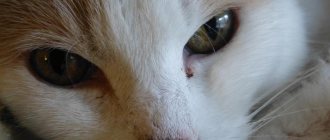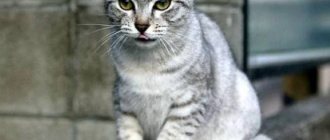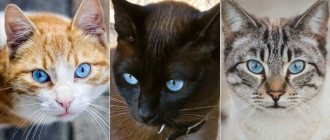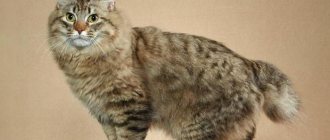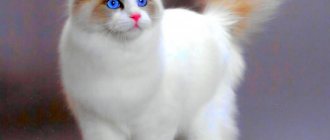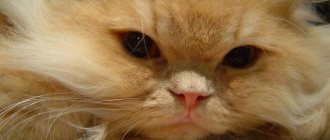Brief description of the breed
It is believed that for several hundred centuries, Siamese cats were akin to domestic deities - only the nobility turned them on, and commoners could only admire these heavenly-eyed creatures. Today Siam, which has existed for almost 7 centuries, is called Thailand. And not only the name of the state has changed - a metamorphosis has also occurred with the appearance of Siamese cats. Until the mid-1950s, the breed standard required these animals to have a rounded head, not so widely spaced ears, a relatively short body and medium-length paws (they looked similar to Thai cats). But the modern appearance of Siamese cats is somewhat different - their head has become elongated, their ears have become large and widely set, and their body and limbs have become elongated and toned.
These cats also gained popularity in Europe - the first individuals arrived in the British Isles in the 19th century, and they were imported into the Russian Empire at the beginning of the 20th century. Since then, the Siamese breed has consistently ranked among the top 10 most beloved cats in different countries. Moreover, the interest is due not only to their exquisite exterior (they resemble ancient Egyptian cats in appearance), but also to their excellent character. Siamese very quickly become attached to people, they are quite good-natured, intelligent and inquisitive. In addition, these animals often live to an old age - 20 years or more. But some lucky Siamese can reach their 30th birthday, like a cat of this breed named Scooter, born in 1986 in the USA (in 2016, the mustachioed centenarian, unfortunately, passed away).
When looking at them, Siamese cats give the impression of being moderately muscular and slender animals of medium size. Their weight ranges from 3.5 to 7 kg, and their body length is approximately 65-70 cm. Males are usually larger than cats. The head of these animals is wedge-shaped and narrow, proportional to the body, the transition from the frontal part to the long nose is straight. The ears are large and wide at the base. The eyes are quite large, almond-shaped, blue or blue in color of varying saturation, strabismus (squint) is undesirable. The neck is dry and long, turning into a tube-shaped elongated muscular body. The limbs are long and graceful, with small oval paws. The tail is long, narrow in diameter, without a break. The hair of Siamese cats is soft, short, lies close to the body, without undercoat. The colors of Siamese are pointing - dark (of the same color) markings on the face, ears, limbs and tail, the main body tone is always light - blue, cream, white with a yellow tint, light orange. By the way, Siamese are born white, and the color begins to darken around the end of the first week of life (this finally happens by 8-10 months).
Description and appearance
Siamese cats are small in size and have small bones. Domestic cats are very graceful and flexible. The build of the individuals is proportional, although they seem very thin and fragile.
The head is characterized by an elongated shape, the wedge is well defined. The muzzle is graceful, the jaws and chin are medium. There is no transition from the nose to the frontal part.
Purebred Siamese cats have slightly slanted eyes, they are simply almond-shaped with a radiant blue hue. Strabismus is not typical for all Siamese cats; cats are usually distinguished by this particular arrangement of their eyes.
Note! No matter how broken the tip of the tail is today, it is not considered the main standard of the breed.
Breed standards
By modern standards, Siamese and Orientals are considered practically the same breed. Individuals are often crossed with each other. The color of Point Siamese is considered normal, even if there are slight darkenings on the sides. Representatives with dark spots in the groin, on the chest, and even if there are white spots on the tips of the paws are non-standard.
Loss of contrast is a reason for disqualification, but this applies to exhibition specimens. At the same time, the formation of color cannot be influenced in any way by selection. At the present stage, breeders are seeking changes in ear size. Particularly prized are the large shells, which give the specimens a completely new appearance.
Varieties of colors
An interesting breed coloring is called point; it is characterized by dark markings on the ears, muzzle, paws and tail. The wool of individuals has the peculiarity of darkening at low temperatures. The color also depends on the age of the individuals; it usually stabilizes by 10 months of the animal’s life, so it is difficult to distinguish the shades from a newborn kitten.
Note! The breed's color options are varied. There are quite a lot of Siamese in nature with light and dark components. The colors are called seal point, chocolate, blue point, lilac, blue, flame point, but red Siamese can also be born.
What is the difference between a Siamese cat and a Thai cat?
The Thai cat is an older type of Siamese breed. Enthusiasts made every effort to ensure that this subspecies was identified as a separate breed. Most domestic Siamese cats should in fact be called Thai. The main differences can be distinguished by specialists, but they include the following features:
- the body of the Taek is more rounded, while that of the Siamese is elongated, looking like emaciated; the ears of the Taikas are rounded and not folded, while those of the Siamese are pointed; the Taek's tail is of medium length and not long-haired; in Siamese it is a thin whip; The shape of the eyes is also different: Siamese have slanted eyes, “Thais” have rounder pupils.
basic information
| Breed name: | Siamese cat |
| Country of origin: | Thailand |
| Time of origin of the breed: | 1960s |
| Weight: | 3 – 5 kg |
| EMS code: | SIA |
| Lifespan: | 13 – 15 years |
| Price of kittens: | 50 — 500 $ |
| The most popular nicknames: | list of names for Siamese cats |
Estimation of breed characteristics
| Adaptability (Definition meaning how easily a cat can adapt to changes in life) |




